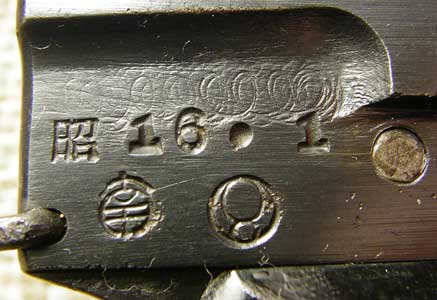Nambu World: Showa 16.1 Type 94
I got this
Type 94 along with T26 serial #5070 from a collector in

The left side shows more pitting, as is almost always the case with Japanese pistols, since this was the side worn next to the body and hence most likely to be exposed to sweat and corrosion. The long dog-legged bar that extends from a rounded end above the trigger to almost the back of the pistol is the sear bar. Pressing on the front tip with the safety off can cause the gun to fire without touching the trigger.

The right
side has the date and manufacturer’s marks. The date 16.1 means the first month
of the sixteenth year of Emperor Hirohito’s reign, i.e. January, 1941. The
character in front of that number is Sho,
short for Showa, the name of Hirohito’s reign. Below that are two characters.
The first one is a stylized

The serial number is on the right side above the trigger guard.

These
markings above the trigger on the left side are the model designation. From
right to left they read kyu-yon-shiki,
or Type 94. This designation comes from the year the gun was approved, 1934,
which was 2594 by the Japanese calendar, which begins in 660 BC, the date the semi-mythical
first emperor of

At the rear of the gun the little lever is the safety. It is in the fire position, pointing to a Japanese character that means literally “fire”. The vertical position is safe, and points to a character that means “peace”, and is the first character in the Japanese term for safety.

Here is a close-up that shows the worst area of pitting. Fortunately the inside of the gun is immaculate and shows almost no wear.

The
magazine number matches the last three digits of the gun’s serial number, as it
should. The inspection mark below the first 9 is the character To as in

The crossbolt, the oval area with the horizontal striations, is what holds the slide and bolt together. This is the first one I have seen with these striations.

Click here to go back to the Type 94 Photo
Gallery: Type 94 Photo
Gallery
Click here to go back to Nambu World: Teri’s
WWII Japanese Handgun home page: Nambu World: Teri’s WWII Japanese
Handgun Website
Last updated: November 11, 2006. All contents are copyright Teri unless otherwise specified and may not
be used elsewhere in any form without prior permission.